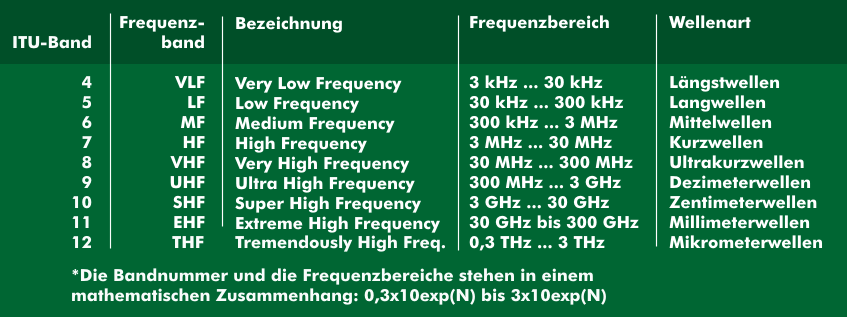ultra high frequency (UHF)
The UHF (Ultra High Frequency) frequency range extends from about 300 MHz to 3 GHz. The corresponding wavelength range is the decimeter wave range and has wavelengths between 1 m and 10 cm. The UHF band has the band number 9 at the International Telecommunication Union( ITU). From the band number, the frequency range can be determined using the formula `0.3*10^9`.
The UHF range is the decisive frequency range for almost all radio technologies. It was already released many years ago for analogtelevision and has the advantage that the bandwidth of the channels can be relatively large, as with television, and that, depending on the frequency range, the free space attenuation can be well controlled. The digitization of transmission technology has made it possible to improve the frequency economy considerably, so that the UHF range can be used for many modern communications technologies. In this context, reference should be made to the freed-up transmission bands of analog television, whose frequency bands are available as the digital dividend.
Since some services use identical UHF frequency bands, such as Bluetooth, WLAN, ZigBee, Long Term Evolution( LTE), they could influence each other or impair their transmission through interference. To prevent this, there are sophisticated modulation methods that work with a spread frequency band or with frequency switching.
The UHF band is used for mobile TV and digital radio( DAB), for mobile networks such as GSM, UMTS, Long Term Evolution (LTE) and the new 5th generation mobile communications standard( 5G), for professional mobile radio and cordless telephony, for SDR techniques and, above all, for WLANs in accordance with IEEE 802.11, for Bluetooth, ZigBee, Z-Wave and RFID. Within the UHF range, there are also frequency ranges for astronomical applications, for radio microphones and wireless systems.
Several frequency bands were available in Europe for classic, analog television. These included Band IV with frequencies between 470 MHz and 582 MHz and Band V with frequencies between 582 MHz and 862 MHz. In America, Band V extended to 960 MHz. These bands were used for terrestrial television and parts of them are used for digital TV( DVB). After the shutdown of terrestrial television transmission, terrestrial digital television, DVB-T, is transmitted in the 8 MHz wide television channels. Band IV consists of the fourteen channels 21 to 34, Band V of the 35 channels 35 to 69.

